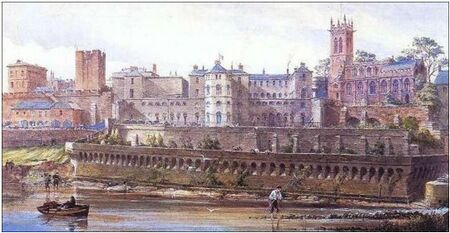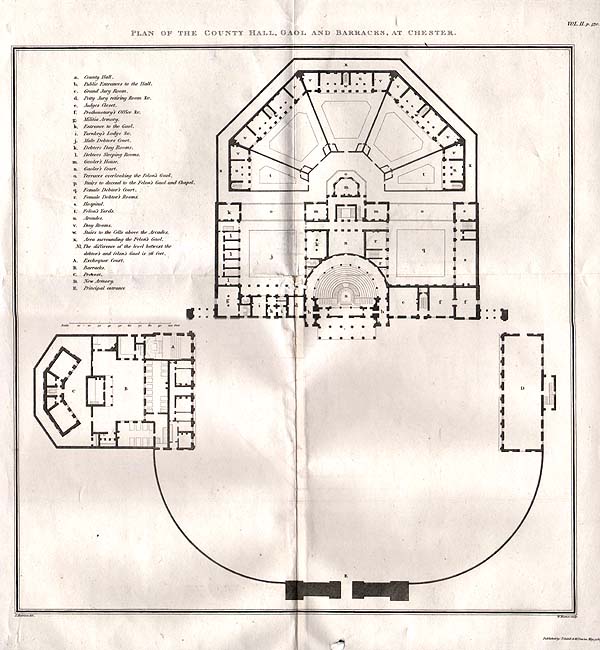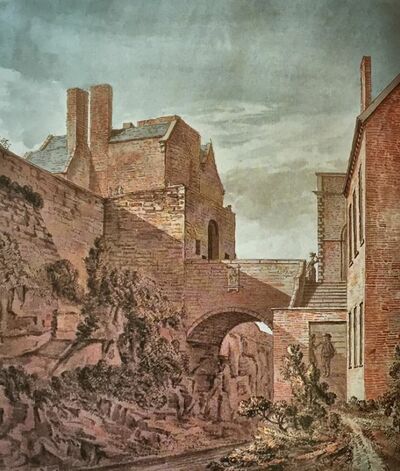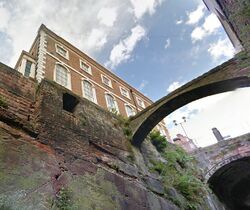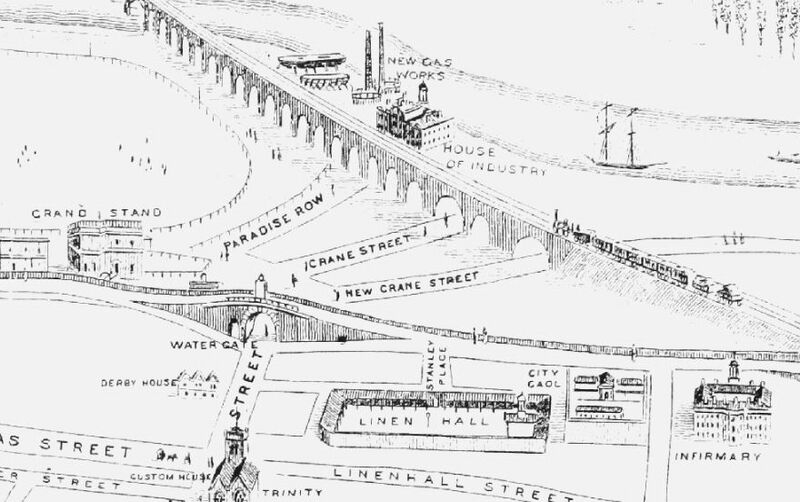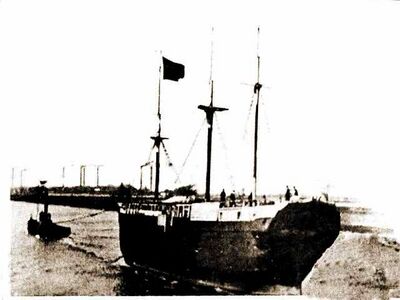City Gaol
The city of Chester was peculiar in that (except for the castle and the area known as Gloverstone) it was a county of itself, separate in administration from the county of Cheshire. This complicated the legal system and one result was that both the county and the city had separate prisons in Chester.
Prisons in Chester
Like many castles, Chester Castle held prisoners in "the dungeons" from as early as 1241 when hostages from the Welsh side of the border were held there. Little is known about the location of these facilities or the conditions. However it is unlikely that any "common-man" inmates were confined for crimes: the law at the time hardly considereed the expensive process of imprisonment as part of the system of justice. Hostages, being of some value and others held for ransom were a different matter. An even earlier prisoner may have been Gruffudd ap Cynan who was said to have been held there by Hugh of Avranches from 1081, although there are conflicts of dates.
In 1292/3 the outer gatehouse of the Castle was re-built specifically with cells for prisoners. This structure no longer exists. By the 1680’s it was in a state of disrepair, with the Crown meeting the costs of repair, and the maintenance then passed to the local authorities. By the 1770’s, the prison was compared by John Howard, the prison reformer, as being like the "black hole of Calcutta". Chester Castle had traditionally held prisoners awaiting trial who came from the County of Cheshire, (as opposed to the City of Chester) and the City of Chester had their own City Gaol, up to 1810 in Northgate, and latterly in the New City Gaol and House of Correction which stood on the City walls near the Infirmary until its closure in 1872.
Chester City authorities had the responsibility for the execution of all felons sentenced to death, and prisoners from the Castle (County prisoners) were handed over to City officials at the ‘Gloverstone’ on the morning of the execution (see also: Execution at Chester). It appears that many of the early "county" executions were carried out at Boughton. The reason for this rather odd division of duties dated back to a charter making the City (excepting the Castle) a county in its own right and splitting the jurisdiction of the City and County authorities.
In 1785 it was decreed that the Castle prison should be rebuilt, and a competition was held to find the best design. Thomas Harrison won the contract, and the New Prison opened in 1793 becoming a major riverside landmark. It had areas for civil and debtors prisoners, and was then considered to be one of the best in the country. The prison was again found inadequate in 1865, and a rebuilding program took place in 1869. The prison transferred to the Crown in 1877, and it closed to prisoners in 1884. It remained a military prison until 1893, and demolished in 1900, when it was taken over by the County Council.
Chester Castle
Chester Castle had been used as a gaol since at least c1241. Its history as a prison is largely incorporated into the pages on its more general history. It's most famous prisoner was Richard II (see: Royal Treasure). There is some doubt where in the castle he was held. Some writers state that he was held in the outher gatehouse, others in the Agricola Tower, once the inner gatehouse. Batenham writes of the Agricola Tower:
- A room on the first story is remarkable for its curious workmanship and groined roof this was formerly a chapel the stone vessel that held the holy water and some scattered remains of fresco painting are remaining on different parts of the walls. Over this is another room bearing evident marks of its having been a prison and is said to be the place wherein the unfortunate King Richard II was confined on his journey to London in 1399.
Other notables incarcerated here include James Stanley the 7th Earl of Derby, who escaped but was recaptured. Eleanor Cobham, an English noblewoman who was mistress to the Duke of Gloucester and then became his second wife was charged with Witchcraft by King Henry VI: she was briefly imprisoned at Chester Castle (see: Witch Trials). The Agricola Tower is described at length in Samuel Lewis's 1848 Topographical Dictionary of England:
- Of the ancient castle, built by the Conqueror, there remains only a large square tower, called "Julius Agricola's Tower," now used as a magazine for gunpowder. Though of modern appearance, having been newly fronted, it is undoubtedly of great antiquity, and interesting as the probable place of confinement of the Earl of Derby, and the place in which Richard II., and Margaret, Countess of Richmond, were imprisoned. In the second chamber James II. heard mass, on his tour through this part of the kingdom, a short time previously to the Revolution. This apartment, when opened after many years of disuse as a chapel, exhibited, from the richness of its decorations, a splendid appearance, the walls being completely covered with paintings in fresco, as vivid and beautiful as when executed; and the roof, from the fine effect produced by the ribs of the groined arches, springing elegantly from slender pillars with capitals in a chaste and curious style, was equally striking.

While Margaret Countess of Richmond is mentioned as a prisoner by Lewis, it is improbable that she was. Interestingly the wall of the room above the chapel in the Agricola Tower has some marks on the wall which may be mason's marks but one of which may be the "Sign of Four" symbol. This was an outgrowth of an ancient symbol adopted by the Romans and by Christianity, Chi Rho (XP), standing for the first two letters of "Christos" in Greek letters (ΧΡΙΣΤΟΣ); this was simplified to a reversed "4" in Medieval times. This symbol was sometimes used as a "Witch Mark" to prevent evil influence.
Old Gaol
By the sixteenth century, the gaol was located in the outer gatehouse and apparently the adjacent former exchequer. In the 1580s and 1590s, it was used to detain Catholic recusants. During the English Civil War, it was refurbished and held royalist prisoners, with a large number being detained there after the Battle of Worcester in 1651. In the 1680s, the decaying building was renovated by the Crown but it was then left to the county to maintain it. In 1729, the commitment fee for every prisoner was set at 8s. 2d.. The chamber rent for a prisoner providing his own bedding was 1s. A charge of 1s. a week was made for bedding provided by the constable.
John Howard described the old gaol as follows:
- "This castle is the property of the King. The first room is a hall : there are two staircases leading up from it to four rooms for master's-side debtors. Down 18 steps is a small court, which was common to debtors and felons. It is lately divided, but the high close pales which separate the two courts, now so very small, deprive both debtors and felons of the benefit of fresh air, and the keeper has no view of the felons court or day-room, in which men and women are together: the debtors, in the pope's kitchen (improperly called their free ward, as they pay one shilling a week each); the felons, in their day-room, the king's kitchen. Both these are 6 steps below the court: each of them about 35 feet by 22. Near the former is the condemned room. Under the king's kitchen is the king's cellar; quite useless. Under the pope's kitchen is a dark passage 24 feet by 9: the descent to it, is by 21 steps from the court. No window : not a breath of fresh air : only two apertures (lately made) with grates in the ceiling into the pope's kitchen above. On one side of it are six cells (stalls) each about 7½ feet by 3, with a barrack-bedstead, and an aperture over the door about 8 inches by 4. In each of these are locked up at night, sometimes three or four felons. They pitch these dungeons two or three times a year: when I was in one of them, I ordered the door to be shut; and my situation brought to mind what I had heard of the black hole at Calcuta. The felons day-room is not secure. They escaped in 1775, by breaking through the slight floor into the king's cellar below; and through the decayed walls of that they made their way down the hill. The keeper, who is careful and humane, was not blameable. Transports had not the king's allowance of 2s. 6d. a week. Of the debtors whom I saw in 1776, five were imprisoned by exchequer writs; and five also in 1782. The costs of some were equal to the debts. The county has lately built two good rooms for the gaoler, and fitted up one room for a chapel. But there is no infirmary or bath, which are peculiarly necessary in so close a prison. The act for preserving the health of prisoners not hung up."
New Gaol
On 30 August 1784 it was decided that the present gaol was "insufficient, inconvenient and in want of repair", Howard having compared it with the "Black Hole of Calcutta". There had also been a typhoid epidemic the previous year and it has been suggested that this may have influenced the decision. A competition was announced in April 1785, to ‘rebuild, finish, repair, enlarge the gaol’ on the site of the old gaol and ground to the East and West. It was to accommodate 100 prisoners, though usually only eighty two people were confined. Plans were to be received before 20 July 1785. The prize was 50 guineas and the winning design was submitted by Thomas Harrison, then relatively unknown. The runner-up was William Cole. The new gaol was commissioned by the Justices of the Peace for the County of Cheshire; the building committee, formed in September 1786, included Sir Henry Mainwaring Bt, George Leycester, John Leigh of Oughtrington, and John Legh of Adlington. At this stage, Harrison had no connection with Chester, though he had achieved some fame with his work in Lancaster, at the Castle and the Skerton Bridge. Harrison was concerned initially with the Gaol only, although he was also asked to prepare plans in the event of the Shire Hall and adjacent buildings being demolished.
The leading architect to specialise in prison design at the time was William Blackburn (1750-1790), who was responsible for eighteen prisons, including Oxford, Liverpool and Gloucester. The latter, which owed much to the ideas of its Governor, Sir George Paul, appears to have been influential on Harrison, since, in 1784, Blackburn was paid to review the early plans for Chester.
In 1793 copies of a pamphlet published by Paul "containing many useful hints as to the care and regulation of gaols.." were requested from Gloucester. "The Builder" (vol. 21, p. 204) records a visitor to Chester, a M. Dupin, as commenting:
- "The Sessions House and Panoptic prison of Chester are united in the same building which is assuredly the handsomest of its kind that is to be seen in Europe. The interior arrangements are well contrived and bespeak much regard for humanity. The architecture is equally simple and majestic."
The new prison was praised as one of the best-constructed prisons in the country. It had such endearing features as a raised exercise yard with a delightful view of distant Beeston Castle. The two courtyards at the right and left of the building were originally exercise yards for the male and female debtors respectively. The semi-octagonal felons jail originally radiated from below the central bay with the Governor's house in the right hand wing. The jail was thus the first in England to have been built on the overview principle advocated by John Howard in his State of the Prisons of 1780 and later by Jeremy Bentham in his publication "Panopticon" of 1791. However, it was a project that was to take 37 years, was plagued by financial problems, needed two separate Acts of Parliament and was slowed down by poor workmanship (much of the work being undertaken by a badly housed and often-undernourished population of convicts). While Harrison submitted the winning plans, and fleshed them out in 1792/3 he did little else until 1794 when it was discovered that William Bell, the superintendent of works since 1788, had wasted stone and embezzled funds and materials. Bell was dismissed, and Harrison, who seems to have been responsible for his exposure, replaced him as surveyor. Examination of the work supervised by Bell revealed that the pillars in the prison chapel would not support the planned superstructure and there were additional delays while the foundations were relaid. A new contractor, William Cole the elder, was only appointed in 1797. The main block seems to have been completed shortly after, for in 1800 the finishing touches were put to the portico and prison chapel. Robert Southey commented on how comfortably the jailor was housed:
- "The new jail is considered as a perfect model of prison architecture… The main objects attended to are, that the prisoners be kept apart from each other, and that the cells should always be open to inspection, and well ventilated so as to prevent infectious disorders… The structure of this particular prison is singularly curious, the cells being so constructed that the jailor from his dwelling-house can look into every one…The apartment from whence we were shown the interior of the prison was well, and even elegantly furnished; there were geraniums flowering upon stands, – a pianoforte, and music-books lying open – , and when we looked from the window we saw criminals with irons upon their legs, in solitary dungeons: – one of them, who was intently reading some devotional book, was, we were told, certainly to be executed at the next assizes…"
The Cells were descibed as follows:
- "Their dimensions are 12 feet 6 inches by 7 feet 6 inches. Light by day is obtained from an iron-framed window 2 feet three inches by 2 feet 3 inches, which compared with the windows of the cells in the old part of the prison looks large ; while at night the cell is lit with gas, which can be turned off and on only at the out- side. An iron bracket stands out from the wall and supports a square piece of wood, which is to serve as a table." (Cheshire Observer, January 1869.)
The construction of the new prison involved the destruction of a section of the City Walls, which were rebuilt, in part, along the bank of the River Dee. This extension of the prison yard also saw the end of Skinners Lane.

Northgate

There was a town gaol at the Northgate in the custody of the serjeant of the gate by 1294. In the mid 14th century that arrangement was believed to have existed time out of mind, and although there was no formal grant of the right to keep a gaol, the citizens were empowered in 1300 to lodge there anyone arrested within the liberties, awaiting gaol delivery according to city custom, which amounted to the same thing. The prison, and the gallows and pillory associated with it, were often in the later Middle Ages managed by an underkeeper who paid the serjeant of the Northgate for his office. The serjeanty was hereditary from the 14th century. In 1498–9 the mayor and citizens laid claim to it; perhaps then and certainly by 1541 they established their right, and control of the prison passed to the city sheriffs. They paid rent to the corporation and appointed a gaoler, styled keeper or underkeeper, and a hangman. The Assembly removed appointments into its own hands in 1618, but by the 1660s and throughout the 18th century each October the incoming sheriffs reappointed the underkeeper or deputy keeper, who indemnified them against any escapes and undertook to find an executioner. From 1767 the deputy keeper was paid an annual salary rather than left entirely dependent on fees and perquisites.
Offenders were gaoled in the 16th and 17th centuries for gambling, adultery, insulting the mayor, debt, negligence on watch, and many other transgressions. Most seem to have been detained for only short periods, except for debtors, some of whom in the 18th century remained in the Northgate for 10 years or more. Deserters from the army and convicts awaiting transportation were also held. Total numbers in the later 18th century seem rarely to have reached 20, and probably most of the time debtors were in the majority. Charitable bequests and gifts made between 1594 and 1615 by Hugh and Robert Offley, Thomas Green, Valentine Broughton, and John Vernon provided small amounts of money for the prisoners to buy food and other necessities.
Debtors were lodged in the 'free house' over the gate, from where in 1540 they were at liberty to attend services in St. John's chapel, or to walk on the northern stretch of the City Walls or along Northgate Street but only as far as the Bull Inn. In 1777 debtors were well housed in a series of rooms, gentlemen among them using the 'blue room' at a weekly rent of 5s. Felons had a spacious day room, but at night were confined in an underground cell merely 14 ft by 8 ft, down a flight of 18 steps, without light, and ventilated only by two narrow pipes leading up to ground level. Women felons occupied a windowless upper dungeon.
Chester established a Workhouse/House of Correction in 1575 when a building just outside the Northgate "near the quarry in the Gorse Stacks" was converted for this purpose. The building in question had been removed from elsewhere in the city and had originally been the butcher's Shambles:
- "This year there was a collection made in the city and of some worshipful in the county for a stock to set the poor on work and a house of correction built under the city wall near unto the Northgate which house was removed out of the corn market and was first placed there by Mr Webster for the butchers of the city."
The House of Correction was located in the "Quarrel", a deep quarry outside the walls east of the Northgate, later cut through by the canal. It included workrooms on two storeys. In its courtyard a narrow space in the face of the quarry was used in the 17th century to confine refractory youths, and during the Interregnum, Quakers, for a few hours in a tortured position where they could neither stand, sit, kneel, or lie. It was known, euphemistically, as "Little Ease". The original bridewell was pulled down by the city's defenders during the Civil War siege, but was replaced in 1655–7 by a new house of correction on the same site. Initially intended to provide corrective employment for the able-bodied destitute in tasks such as weaving cloth, it came, like similar establishments elsewhere, to be used as a prison for minor offenders convicted by the magistrates. In the 1770s a workshop and two "dungeons" were added. It was closed in 1808 and was briefly a school before it was sold in 1817 to a Joseph Fletcher, who converted the buildings into dwellings. Later it became the site of the Northgate Bakery.
Hemingway writes of the 1787 visit of the prison reformer John Howard to Northgate Gaol as follows:
- "In the city gaol the convicts and prisoners for trial were severely ironed by the neck hands waist and feet and chained to the floor and at night to their beds in the horrid dungeon. Here was the first iron glove I have seen in England which though not yet used shews the severity of the gaoler's disposition. Allowance a pennyworth of bread for felons and a pound for debtors inferior in quality to that sold in the city. Debtors and felons are allowed to beg some hours in the day. That prisoners are not supplied with necessary food is a disgrace to such an opulent city. No proper separation of men and women either here or in the county gaol. City Bridewell: - no employment, no allowance, court not secure keeper's salary only £4. He sells beer"
The new Northgate was built in place of the former medieval Gatehouse in 1810 by County architect Thomas Harrison for the City Council. What remains of the gaol includes the so-called "Bridge of Sighs". It is described by Ronald Leigh in his memories recorded at the The Museum of Policing in Cheshire as follows:
- Prisons unfortunately always seem to be necessary in any form of communal life and Chester seems to be no exception. No doubt the Romans had one but this is no longer apparent. However the site at the one at the Northgate is still on record. It forms part of the actual Northgate and the dungeons were in the sandstone rock of its foundations. The place of execution was also in the jail itself and prisoners before their execution were taken outside the walls to the church of Little St. John, which stood on or near the present site of the Blue Coat building. It was found that whilst taking this last walk, friends of such prisoners frequently staged attempts to free them. In order to foil such attempts by these footpads thieves and felons, the authorities in 1793 built the small bridge which can still be seen, less its protecting railings between the City walls in the west side of Northgate over the moat/canal to the Blue Coat school.
In his 1777 report on the prison John Howard makes it clear that such a bridge was also used by those who were not about to be executed:
- "MR DUKE is Chaplain to the Blue Coat School and officiates in little St John's Chapel belonging to the School. A Navigation parts that from the Prison yard and a foot bridge made for the purpose gives these Prisoners an opportunity of attending Divine Service when it is performed, that is Prayers twice a week and Sermon once a month. Few Prisoners in City or Town Gaols have such a privilege."
As the present bridge dates from 1793, Howard is clearly referring to an earlier, possibly wooden, bridge! Could the opening just west of the present bridge be where it entered the Hospital?
The name of the present bridge is taken from the same-named bridge in Venice which passes over the Rio di Palazzo, and connects the New Prison (Prigioni Nuove) to the interrogation rooms in the Doge's Palace. The one in Venice dates from 1600. The Venetian bridge's English name was supposedly bestowed by Lord Byron (22 January 1788 – 19 April 1824) in the 19th century as a translation from the Italian "Ponte dei sospiri", from the suggestion that prisoners would sigh at their final view of beautiful Venice through the window before being taken down to their cells. The Chester bridge cost £20 to build in 1793, and was designed by Joeseph Turner. During WWII the metal railings were removed to be melted down (like many others) as a potential source of metal and were probably either dumped at sea or exported as ship's ballast. At the time that the bridge was built the majority, if not all, of the executions would have actually taken place at Gallows Hill, Boughton. Very few executions took place at Northgate. On October 3rd 1801 Aaron Gee and Thomas Gibson were hung out of a temporary window on the south side of the old Northgate. It was a somewhat makeshift gallows, they were "propelled from the window about 5 feet and dropped near 40 inches", then proceeded to annoy the jaillor by rattling against his window and breaking the glass. Thereafter, executions moved to the City Gaol
City Gaol
A new combined gaol and house of correction were built in 1807 and opened in 1808. The site, enclosed by a high wall, fronted the later City Walls Road between the Linenhall to the south and the infirmary to the north. The buildings, of brick, were designed by Thomas Harrison, with a neo-classical stone gateway, and had the gaol on the west and house of correction on the east, linked by a chapel serving both. Batenham wrote of it:
- "Nearly adjoining the infirmary stands the City Gaol and House of Correction, comprised in one building which was erected in 1807. The gaol is the western end having a neat entrance of white stone. The house of correction is at the other end over the door of which the drop for the execution of both City and County malefactors is occasionally put up. In the centre of building is the chapel having communication with both prisons each of which has four courts with separate cells and day rooms and each end its seperate jailor; and the whole is under the jurisdiction of the city magistrates. To the credit of our town be it recorded that while the most baneful doctrines are seducing men from their duty and filling other prisons with reprobates disturbers and villains ours is rarely polluted with any capital criminal and even the petty offences are but small in the scale of general depravity."
Although the Chester City House of Correction was located next to the City Gaol and shared the same management, it was considered a separate institution in the 1818 Return and in the Royal Commission of 1835. The new gaol was built out of corporation funds, and the House of Correction from the proceeds of a special city rate. Official returns from 1824, however, merge the two institutions. The Workhouse was closely related to the House of Correction. Initially Workhouses were intended to reduce the cost of poor-relef to parishes for the able-bodied poor who wished to work, whereas the House of Correction was intended "to encourage" the able-bodied poor who were unwilling to work. As the 19th century wore on, workhouses increasingly became refuges for the elderly, infirm, and sick rather than the able-bodied poor.

The gaol passed from the control of the sheriffs to that of the city's J.P.s in 1823. As originally built the two establishments could house 30 prisoners each, though not in separate cells. The Gaols Act of 1823, requiring prisoners to be classified, necessitated alterations, completed by 1825. The Act introduced regular visits to prisoners by chaplains; provided for the payment of gaolers, who had previously been paid out of fees that the prisoners themselves were required to pay; stated that female and male prisoners should be kept separated as well as requiring the installation of female wardens to guard female prisoners; and prohibited the use of irons and manacles. Twenty-seven separate cells, six workrooms, and two schoolrooms were made out of the existing accommodation, and at the same time a resident matron and turnkey were appointed. Lodges on the east and west were demolished and the site was extended east so as to clear a space around the buildings and prevent escapes, which had previously been frequent. The number of cells was sufficient in the 1820s, but less so in the 1830s, when during one race week they held as many as 85. The gaol was commended in 1833 for its cleanliness, orderly management, and healthy situation, but those advantages were soon lost through increasing pressure of numbers and an ineffective governor: in the late 1830s defects were found in security, discipline, prisoners' employment, and staffing. Prison discipline was greatly improved under a new governor appointed in 1839, but the shortage of cells and poor security were not remedied until 1847, when the day wards were converted into cells. There were then 64 separate cells, again insufficient from the later 1860s. Overcrowding was especially acute in the women's quarters. From the 1820s the prison regime included work, and after 1839 all prisoners were given regular employment. The staple tasks were mat-making and oakum-picking, with stone-breaking for men sentenced to hard labour, and laundry work and sewing for women.
The gaol is often said to be one of the first to install a 'drop', or mechanical gallows. The gallows originally stood high on the front of the building where they were used for the public hangings of both Chester and Cheshire criminals. The grisly scenes of death attracted large, ghoulish crowds. There is an old saying in Chester:
- "Five days racing, one day hanging"
..which refers to the fact that executions often followed a Race Meeting and these meetings only swelled the crowds. The first execution here was on 6th May 1809 when George Glover and William Proudlove were hung for shooting at (and missing) an excise officer. The drop was used for the first time and the ropes broke, leaving the two still alive. New ropes were procured and the sentence carried out about 1 hour later. Apparently, the two condemned men remained remarkably calm during their wait for their repeat performance, and did not pretend innocence proven by "divine intervention" (the present author would have!). Contrary to popular belief, there is no actual provision in English law that if the rope breaks or the trap jams you get set free. However there were a very few cases where a sentence was commuted after a failed hanging - but none in Chester.
The disused graveyard next to the gaol still exists, but was not owned by the gaol and belonged to Holy Trinity. Hemingway wrote of it:
- "The burying place adjoining to the church having been exceedingly crowded with bodies and inadequate to the use of the parish a fresh piece of ground north of the Linen hall and east of the city gaol was purchased in 1809 and consecrated September 22nd 1810 the total expense including the chapel railing &c was about £1000."
At the time the punishment for murder included post-mortem public dissection and the remains of murderers were seldom buried. After 1834, the bodies of all criminals executed were buried within the precincts of the prison in which they were last confined (presumably in most cases Chester Castle), in unmarked graves whose locations were recorded. Prior to 1834 the bodies of those executed for crimes other than murder could be claimed by relatives and friends for burial in consecrated land - unless they had been "hung in chains" from a gibbet. It seems some bodies ended-up at St Martins, others at St Mary on the Hill. See: Execution at Chester for more detail on individual cases.
Most prisoners were locked up for breaches of the peace, vagrancy, or prostitution, and served short sentences. In the year 1861–2, for example, only 9 of 413 prisoners were serving more than a year, and most were on summary convictions of less than a month. Every race week brought a wave of petty crime and saw the gaol filled beyond its capacity. Perhaps the most severe problem was the inability, through lack of space, to segregate prisoners of different categories. As standards rose elsewhere the gaol's defects became ever more apparent. The government inspectors pressed for improvements, though were aware that the constricted site made enlargement out of the question. In 1871 they condemned the gaol, by then grossly overcrowded, as 'most unsatisfactory', and it was closed by the Home Office in 1872 under the 1865 Prison Act. The buildings were demolished soon afterwards, and the Queen's school was later built on the site. The Queen's school was established for middle-class girls in 1878 and moved to the new building in City Walls Road in 1883. Evidently there was a school on the same site beforehand as John Broster writing in 1821 states:
- On a piece of ground next to the Infirmary, is erected a commodius building for the reception of of a certain number of girls, who are maintained and educated, so as to qualify them for servants. It is supported by voluntary contributions and subscriptions.
This is a little confusing as the gaol existed here from 1808 to the early 1880's.
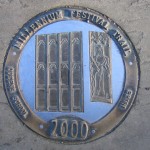
Police Lock-ups
By 1837 there were two overnight lock-ups for vagrants in the yard of the city gaol. They were replaced in 1839 by two police cells next to the Exchange, which were far too small for the numbers confined there almost every Saturday and Sunday night. The building was enlarged to six cells on two storeys in 1844 or 1845; at least 1,000 people a year spent a night in them in the late 1840s. They were destroyed in 1862 when the Exchange burned down, and two cells in the gaol were used as temporary lock-ups, causing much night-time disturbance, until the new Town Hall, which incorporated a police station and cells in the basement, was opened in 1869.
Transportation
Penal transportation (or simply transportation) was the relocation of convicted criminals, or other persons regarded as undesirable, to a distant place, often a colony, for a specified term; later, specifically established penal colonies became their destination. While the prisoners may have been released once the sentences were served, they generally did not have the resources to return home. Transportation removed the offender from society, mostly permanently, but was seen as more merciful than capital punishment. This method was used for criminals, debtors, military prisoners, and political prisoners.
England transported an estimated 50,000 to 120,000 convicts and political prisoners, as well as prisoners of war from Scotland and Ireland, to its overseas colonies in the Americas from the 1610s until early in the American Revolution in 1776, when transportation to America was temporarily suspended by the Criminal Law Act 1776 (16 Geo. 3. c. 43). The practice was mandated in Scotland by an act of 1785, but was less used there than in England. Transportation on a large scale resumed with the departure of the First Fleet to Australia in 1787, and continued there until 1868.
There are "urban legends" about prison ships at Chester. While many felons were transported they were taken overland to ports from which they departed. These all seem to stem from the story of the convict ship "Success". Success was formerly a merchant ship of 621 tons, 117 feet 3 inches x 26 feet 8 inches x 22 feet 5 inches depth of hold, built in Natmoo, Tenasserim, Burma, in 1840. After initially trading around the Indian subcontinent, she was sold to London owners and made three voyages with emigrants (not convicts) to Australia during the 1840s. On 31 May 1852, Success arrived at Melbourne and the crew the height of the Victorian gold rush. Due to an increase in crime, prisons were overflowing and the Government of Victoria purchased large sailing ships to be employed as prison hulks. These included Success, Deborah, Sacramento and President. In 1857 prisoners from Success "stoned to death" the Superintendent of Prisons John Price, the inspiration for the character Maurice Frere in Marcus Clarke's novel For the Term of His Natural Life. Price had aristocratic connections which aided him in securing the position. Although he was initially seen as restoring order after an incompetent predecessor, Price scoffed at the idea of rehabilitation for convicts. An enthusiasm for flogging for trivial breaches of discipline and extreme corporal punishments "of his own devising" had led to his regime being denounced, but no action had been taken.
Sometime after the murder of Price the ship was converted from a convict hulk into a stores vessel and anchored on the Yarra River, where she remained for the next 36 years. In 1890, Success was purchased by a group of entrepreneurs to be refitted as a museum ship to travel the world advertising the perceived horrors of the convict era - complete with a rather incongruous "iron maiden". Although never a convict ship, and briefly a prison hulk, Success was billed as one, her earlier history being amalgamated with those other ships of the same name including Success, which had been used in the original European settlement of Western Australia. She was incorrectly promoted as the oldest ship afloat. In 1895 she made a trip to England (in itself an almost insane voyage) and sometime before 1912 was towed up the Dee to visit Chester, where she became the last large ship to visit the city. Over the years the memory of her visit has been wrongly transformed into her being the last convict ship to sail from Chester.
It was was then decided that Success would be taken to America and she was re-fitted at Lancaster for the transatlantic voyage. Her departure was briefly delayed by difficulties in finding a crew, with several sailors claiming she was ‘haunted by the ghosts of dead malefactors’. This delay proved fortunate for H. D. Smith, the General Manager of the company that owned the Success – he’d been intending to see her off before taking a berth on the Titanic for a more comfortable crossing! As it was, the Success didn’t set sail until the 15th April 1912, the same day the Titanic sank.
Success was becoming rapidly unseaworthy. She was towed to Sandusky, Ohio, on Lake Erie, Ohio, to be dismantled and sold as scrap. A strong storm sank her at her moorings at Sandusky. A salvage operator named Walter Kolbe acquired the rights to her and in the summer of 1945 he had Success towed to nearby Port Clinton. Unable to enter the shallow port, she grounded just east of Port Clinton. On 4 July 1946 a fire broke out aboard Success, and in the course of the afternoon she burned to the waterline.
Sources and Links
Related Pages
- Execution at Chester;
- Harrison;
- Boughton;
- St Giles Cemetery;
- Gloverstone;
- Chester Castle;
- Courts;
- Northgate;
- Infirmary;
- Workhouse;
